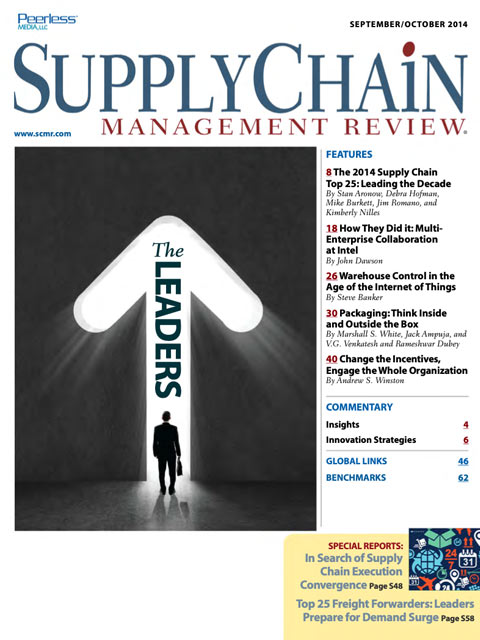Sorry, but your login has failed. Please recheck your login information and resubmit. If your subscription has expired, renew here.
September-October 2014
2014 marks the 10 year anniversary of the Gartner Supply Chain Top 25 ranking. This year we have a diverse set of large, global companies with mature, demand-driven supply chains. There are lessons to be learned from these supply chain leaders, many of whom have led their industries over the past decade. Browse this issue archive.Need Help? Contact customer service 847-559-7581 More options
In the age of the Internet of Things, an increasing number of materials handling systems (MHS), and even components of the larger systems, are gaining both sensors and intelligence. However, existing warehouse control systems (WCS) have not been engineered for this new age. Going forward, we believe that warehouse management (WMS) and warehouse control systems architectures need to be re-conceptualized to enable optimum warehouse performance.
Materials Handling Systems and the Internet of Things
In one definition of the term “Internet of Things,” almost all objects have sensors, connectivity to a broader environment, and intelligence. Sometimes the object has just a sliver of intelligence; but it can be much more substantial. Objects can be products, equipment, containers, or other things as well. For our purposes, the objects we are focused on are forms of materials handling equipment.
Traditionally, we said that warehouses were operated in either a manual, semi-automated, or highly automated fashion. In a manual warehouse, pickers used carts, forklifts, and other “dumb” forms of carriage to go to picking locations, gather the inventory, and deliver those goods to the shipping dock. However, forklifts are becoming intelligent. With the right kind of control system, a warehouse using forklifts becomes semi-automated.
 |
This complete article is available to subscribers
only. Click on Log In Now at the top of this article for full access. Or, Start your PLUS+ subscription for instant access. |
Not ready to subscribe, but need this article?
Buy the complete article now. Only $20.00. Instant PDF Download.
Access the complete issue of Supply Chain Management Review magazine featuring
this article including every word, chart and table exactly as it appeared in the magazine.
SC
MR
Sorry, but your login has failed. Please recheck your login information and resubmit. If your subscription has expired, renew here.
September-October 2014
2014 marks the 10 year anniversary of the Gartner Supply Chain Top 25 ranking. This year we have a diverse set of large, global companies with mature, demand-driven supply chains. There are lessons to be… Browse this issue archive. Access your online digital edition. Download a PDF file of the September-October 2014 issue.
 |
Download Article PDF |
In the age of the Internet of Things, an increasing number of materials handling systems (MHS), and even components of the larger systems, are gaining both sensors and intelligence. However, existing warehouse control systems (WCS) have not been engineered for this new age. Going forward, we believe that warehouse management (WMS) and warehouse control systems architectures need to be re-conceptualized to enable optimum warehouse performance.
Materials Handling Systems and the Internet of Things
In one definition of the term “Internet of Things,” almost all objects have sensors, connectivity to a broader environment, and intelligence. Sometimes the object has just a sliver of intelligence; but it can be much more substantial. Objects can be products, equipment, containers, or other things as well. For our purposes, the objects we are focused on are forms of materials handling equipment.
Traditionally, we said that warehouses were operated in either a manual, semi-automated, or highly automated fashion. In a manual warehouse, pickers used carts, forklifts, and other “dumb” forms of carriage to go to picking locations, gather the inventory, and deliver those goods to the shipping dock. However, forklifts are becoming intelligent. With the right kind of control system, a warehouse using forklifts becomes semi-automated.
 |
SUBSCRIBERS: Click here to download PDF of the full article. |
SC
MR

Latest Supply Chain News
- Joseph Esteves named CEO of SGS Maine Pointe
- Employees, employers hold divergent views on upskilling the workforce
- April manufacturing output slides after growing in March
- Q1 sees a solid finish with positive U.S.-bound import growth, notes S&P Global Market Intelligence
- World Trade Centers offers a helping hand to create resilient, interconnected supply chains
- More News
Latest Podcast

 Explore
Explore
Latest Supply Chain News
- Joseph Esteves named CEO of SGS Maine Pointe
- Employees, employers hold divergent views on upskilling the workforce
- April manufacturing output slides after growing in March
- Q1 sees a solid finish with positive U.S.-bound import growth, notes S&P Global Market Intelligence
- World Trade Centers offers a helping hand to create resilient, interconnected supply chains
- 6 Questions With … Sandeep Bhide
- More latest news
Latest Resources

Subscribe

Supply Chain Management Review delivers the best industry content.

Editors’ Picks





